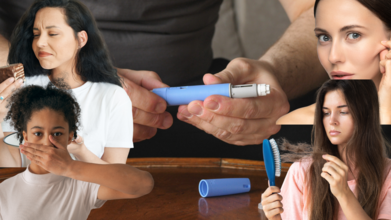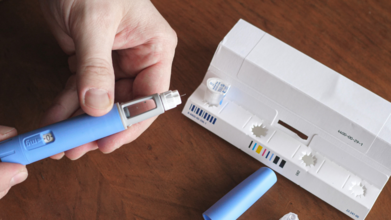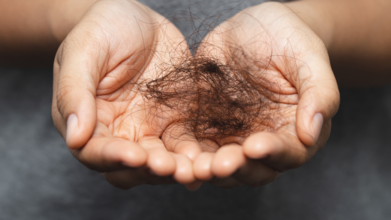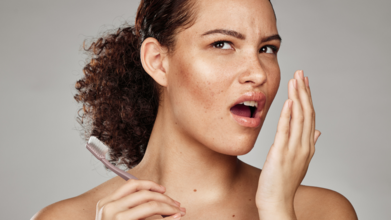- Health Conditions A-Z
- Health & Wellness
- Nutrition
- Fitness
- Health News
- Ayurveda
- Videos
- Medicine A-Z
- Parenting
Ozempic Vulva To Ozempic Smell – Unexpected Ways Of Weight Loss Jabs Change Your Body

(Credit - Canva)
Weight loss jabs have taken over the news, whether it is how quickly the drug runs out or new side effects people may be experiencing. Currently Ozempic is facing a 2 billion dollar lawsuit as many people are claiming that the weight loss drug left them with serious side effects like stomach paralysis, intestinal blockages and persistent vomiting.
GLP-1 medications, like Ozempic, Wegovy, Zepbound, and Mounjaro are all getting cleared of shelves, due to their simple ability to make a person lose weight.
Although it was initially made to treat type 2 diabetes, one of its properties, which is the ability to control hunger, made it wildly popular among those who wish to lose weight or have been struggling to do so.
Semaglutide is the component from Ozempic that gives it the weight loss property. One of the biggest concerns surrounding the weight loss drug is that although it was approved many aspects of it were unknown and still being researched on. As such, it wasn’t a big surprise when we started hearing about bizarre effects, that reportedly started after people started taking weight loss jabs.

Unexpected Side-Effects of Weight Loss Jabs
While weight loss was the expected effect of taking the GLP-1 medicine, people quickly started noticing that they were not just losing weight, but they were also experiencing changes in unexpected body parts. Here is a list of unexpected ways weight loss jabs change your body.
Ozempic Vulva
Some women have reported an unexpected loss of fat in the vulva, which can lead to a sagging appearance and discomfort. This side effect, often called "Ozempic vulva," can cause pain during activities like cycling or sitting. It's a surprising result of rapid weight loss and can be a source of physical and emotional distress for those affected.

Ozempic Smell
This term refers to a peculiar change in a person's sense of smell while on the medication. Some users have noticed a new, intense attraction to sweet scents, particularly those found in gourmand perfumes that smell like baked goods or desserts. This change may be a result of the drug's effect on the brain's reward centers, redirecting cravings from food to fragrance.
Ozempic Hair
Some studies like one published in the MedRxiv suggested that using Ozempic have experienced hair thinning or hair loss. While the drug itself isn't directly proven to cause it, the rapid weight loss it prompts can trigger a condition called telogen effluvium, where hair follicles shed more than usual. This is often a temporary issue, but it can be emotionally difficult for those going through it.

Ozempic Mouth
Reports of Ozempic mouth were also noticed, experts explained that rapid weight loss from medications like Ozempic can cause people to lose fat in their face, leading to a condition some call "Ozempic mouth." This side effect results in new or deeper wrinkles around the mouth, sagging skin, and jowls, which can give a more aged look to the smile and lower face. This loss of volume can make existing lines appear worse.
Ozempic Face
According to Harvard Health rapid weight loss can cause the face to lose fat, leading to a sunken, gaunt, or aged appearance. This is often called "Ozempic face" and is a result of losing fat pads in the cheeks, temples, and under the eyes. This can cause the skin to sag and make wrinkles more prominent, leaving people looking older than they did before.
Ozempic Feet
The rapid loss of fat can also affect the feet. Some users have reported a loss of cushioning on the bottoms of their feet, which can lead to pain when walking or standing for long periods. This condition, referred to as "Ozempic feet," can make everyday activities uncomfortable and may require special padded footwear.

Ozempic Teeth
Some users have reported various dental issues, from chronic dry mouth to increased tooth decay. The medication's effect of slowing down digestion can lead to acid reflux, which erodes tooth enamel, and reduced saliva production, which increases the risk of cavities and gum disease.
Ozempic Appetite
Ozempic can change the way people feel about food, making certain foods they once loved now seem unappealing or even disgusting. This is particularly true for meat and fried foods. The drug affects the brain's reward system, making it less interested in the high-calorie foods it used to crave, essentially rewiring your brain's relationship with food.

Ozempic Blindness
Some new research suggests that in very rare cases, Ozempic and similar drugs might be linked to serious eye problems, including sudden blindness. A study published in the JAMA Ophthalmology found a few patients who experienced severe vision loss while on the medication, due to issues like a lack of blood flow to the nerves in the eye.
Is Ozempic Safe To Use?
As the lawsuit continues, people are worried whether they have to be worried about their health declining due to the weight loss drug. However, Novo Nordisk, the company that makes Ozempic, disagrees with these claims. They state the drug is safe if used correctly and that all medications have some risks. However, people suing the company argue that the full dangers were not shared, especially when the drug was used for weight loss, which it wasn't originally approved for.
Doctor In Matthew Perry Overdose Case Sentenced: What Is Ketamine And How Can An Overdose Affect The Body

California-based Dr. Salvador Plasencia, who supplied 20 vials of ketamine to Matthew Perry, the Friends (1994–2004) star, has been sentenced to 30 months in prison. Perry, 54, was discovered dead in his luxurious Los Angeles home on October 28, 2023. The actor had a history of depression and substance use but was reportedly on the path to recovery. His final on-screen appearance was playing himself in the 2021 feature-length special, *Friends: The Reunion*.
Perry accidentally drowned due to the acute effects of a ketamine overdose. Five individuals faced charges in the case, all of whom eventually pleaded guilty. Dr. Plasencia is the first person to be sentenced in connection with Perry’s death. In addition to his 30-month prison term, he was ordered to pay a fine of $5,600. But what exactly is ketamine, and how can an overdose affect the body?
Doctor Who Supplied Matthew Perry Ketamine Pleads Guilty
Perry was found dead in his hot tub on October 28, 2023, at age 54. The LA County Medical Examiner determined that his death resulted from the “acute effects of ketamine,” with contributing factors including drowning and coronary artery disease. In July 2025, Dr. Plasencia pleaded guilty to felony charges for distributing ketamine to four individuals. He also confirmed that Perry had received multiple doses of the drug prior to his death. Perry’s death in Los Angeles, California, was officially attributed to the “acute effects of ketamine,” which caused him to lose consciousness and drown in his hot tub. He had struggled with substance abuse for years and had been receiving ketamine treatment for anxiety and depression at an accredited clinic, according to the BBC.
What Is Ketamine?
Ketamine is a medication used by doctors as an anesthetic to induce temporary loss of consciousness. Under the Controlled Substances Act, it is classified as a Schedule III non-narcotic substance. The FDA has approved ketamine for use only as a general anesthetic. However, in some cases, doctors prescribe it “off-label” for conditions such as depression. “Off-label” refers to using a drug for a condition that the FDA has not specifically approved.
How Does Ketamine Overdose Harm Your Body?
Certain medical conditions can make ketamine overdose riskier. People with heart disease or high blood pressure may experience increased intracranial pressure, raising the chance of stroke. Blood flow to the heart can be reduced. As a relaxant, excessive ketamine can interfere with breathing, causing it to become shallow. High doses can also be toxic to the liver and urinary bladder. Unregulated or repeated use may lead to dependence and increase the risk of developing schizophrenia.
Side Effects Of Ketamine
At prescribed doses, common side effects of ketamine, according to Medical News Today, include:
- Drowsiness
- Double vision
- Confusion
- Nausea
- Vomiting
- Dizziness
- A general feeling of unease
Ketamine can also cause a wide range of other symptoms affecting different parts of the body, though these are less frequent.
Ketamine As A Drug Of Abuse
Ketamine can produce sensations of detachment from the environment, pain relief, and hallucinations, which has led to its misuse. Recreational users often describe feelings of being separated from their body or a floating sensation. Some report near-total sensory detachment, which they compare to a near-death experience.
The drug is particularly popular among teens and young adults in club settings. Many users prefer ketamine trips to PCP or LSD because the hallucinations are shorter—lasting 30 minutes to an hour—rather than several hours.
Always consult a healthcare professional before starting, stopping, or changing any medication.
The Time Of Christmas Carol Is Here; The Best Part? Singing Is Good For Your Health, Say Studies

Credits: iStock
As December rolls in, familiar melodies float through malls, train stations and sometimes right outside your front door. Carol groups wrapped in tinsel bring a warm sense of nostalgia. Their voices rise in unison, cheerful and bright, filling cold evenings with a comfort that feels almost instinctive. What most people do not realize is that this seasonal tradition may be giving the singers themselves a genuine health lift.
Researchers have been exploring this for years, and their findings suggest that singing is far more than a joyful holiday hobby. It strengthens social bonds, supports emotional wellbeing and even offers physical benefits that reach deep into the brain and lungs.
Why Singing Feels So Good
Alex Street, a researcher at the Cambridge Institute for Music Therapy Research, describes singing as a cognitive, physical, emotional and social act, as reported by BBC. When people sing, especially in groups, the brain lights up in ways few other activities can replicate. Regions responsible for language, movement and emotion get activated at the same time. The steady breathing that singing requires also prompts the release of endorphins, which brings on feelings of pleasure and reduces pain.
Psychologists have long noted how even strangers can develop a sense of togetherness after singing side by side for just an hour. This may explain why community choirs often feel like extended families.
A Simple Workout with Surprising Benefits
Beyond the emotional high, singing demands more from the body than many expect. Studies have shown that it can improve heart rate, circulation and blood pressure. The controlled breathing and longer exhalations strengthen the lungs in ways similar to moderate physical activity. Some researchers even compare a singing session with a brisk walk.
BBC reports that Adam Lewis, an associate professor of respiratory physiotherapy at the University of Southampton, notes that singing encourages people to use their respiratory muscles more efficiently. This is one reason why it has become a useful complementary tool for people living with chronic lung conditions.
Healing Through Harmony
One of the most profound uses of singing is in therapy for people recovering from brain injuries or neurological illnesses. Music therapists often rely on songs from childhood to help patients regain speech or movement. The story of former US congresswoman Gabrielle Giffords is one of the most well known examples, reports BBC. After surviving a severe brain injury, she regained her speech partly through singing familiar melodies during therapy sessions.
Similar approaches have been used with stroke survivors, patients with Parkinson’s disease and people living with dementia. Singing provides repeated vocal practice, encourages focus, and stimulates both sides of the brain. Experts also believe that it may help slow cognitive decline in older adults, although long term studies are still needed.
A Gentle Way Back to Community
For many people living with chronic illness, joining a choir brings something even more meaningful than physical gains. It offers a space where patients, caregivers and professionals participate as equals. Street describes these shared moments as a rare kind of unity that dissolves labels and replaces them with a sense of belonging.
As researchers learn more about the power of song, the message becomes clearer. Singing is not just entertainment. It is a tool for connection, a low cost therapy and a way to strengthen both mind and body. So this festive season, joining a group around the Christmas tree might be more beneficial than you think.
'Immediate And Only Steps' To Protect Yourself From Delhi's Toxic Air, According To Doctor

Credits: iStock
Delhi's Air Quality Index today recorded 'severe' in several location. The Central Pollution Control Board (CPCB) data from 40 monitoring stations from across the city showed AQI above 401 at 7.05 am on Wednesday morning. City's average AQI stood at 376.
While it has only been three days into December, the AQI levels have undergone severe changes. On November 30, Delhi's AQI was recorded at 279, on December 1, it was recorded at 304, while on December 2, the AQI went up to 372.
Amid all this, Dr Ritu Singh, Director Professor and HOD, Department of Biochemistry at Lady Hardinge Medical College posted on her Instagram, what she calls the 'only steps to save your lungs in Delhi".
What Does the Doctor Say?
"If you’re living in Delhi right now, the first line of protection is simple: avoid breathing unfiltered air. If you can’t leave the city, wear an N95 mask every time you step outside or move away from a HEPA-filtered space," says Dr Ritu Singh.
The doctor points out that keeping a high quality HEPA filter at home and at your workplace is essential. She points out that though it may be expensive, but one should know that their "lungs are not replaceable". She says, "Yes, spend all your hard earned money on HEPA filters because the lung is not replaceable."
What Is HEPA Filter? How Does It Help?
As per the US Environmental Protection Agency (EPA), HEPA or also known as the high efficiency particulate air is a type of filter that can theoretically remove at least 99.97% of dust, pollen, mold, bacteria, and any airborne particles with a size of 0.3 microns (µm). The diameter specification of 0.3 microns corresponds to the worst case; the most penetrating particle size (MPPS). Particles that are larger or smaller are trapped with even higher efficiency. Using the worst case particle size results in the worst case efficiency rating (i.e. 99.97% or better for all particle sizes).
What Else Can Be Done To Stay Safe From Air Pollution?
Dr Singh suggests that indoor plants could be added, though it could only offer a "small but meaningful improvement in air quality".
One famous NASA experiment, published in 1989, found that indoor plants can scrub the air of cancer-causing volatile organic compounds like formaldehyde and benzene.
These plants are:
- Spider Plant
- Snake Plant
- Peace Lilly
- Aloe Vera
- Boston Fern
- English Ivy
- Rubber Plant
- Golden Photos
- Bamboo Palm
- Dracaena
The doctor also recommends that one should increase their intakes of antioxidant foods. "Increase your antioxidant intake—turmeric, amla, oranges—these won’t fix pollution, but they help your body cope with oxidative stress.”
Antioxidants strengthen the immune system by fighting oxidative stress, which is caused by unstable molecules called reactive oxygen species (ROS). The body's normal processes, like breathing and metabolism, create free radicals (ROS). Antioxidants donate electrons to these unstable molecules, which neutralizes them and stops them from damaging healthy cells.
"Right now, the goal is extremely clear: prevent inhalation of polluted air. Delhi’s current levels are dangerous for the lungs, the heart, and the entire respiratory system," the doctor says.
© 2024 Bennett, Coleman & Company Limited

